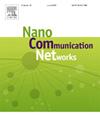A nano-scale quantum-dot multiplexer architecture for logic units in internet of things healthcare systems
IF 4.7
4区 计算机科学
Q2 ENGINEERING, ELECTRICAL & ELECTRONIC
引用次数: 0
Abstract
The Internet of Things (IoT) is a propelling technological shift that enables seamless networking between billions of physical devices across healthcare sectors, agriculture, smart cities, and industrial production lines. By integrating embedded sensors, actuators, and communication modules, IoT systems can gather real-time data, leading to better operational decisions and improved efficiency in healthcare systems. The rapid growth of IoT devices creates three main operational challenges related to power usage, efficiency, and thermal management requirements. The demand for more efficient, compact, high-speed, and energy-efficient devices poses significant challenges for these systems. Traditional complementary metal-oxide-semiconductor (CMOS)-based architectures struggle to meet these demanding requirements, representing a major barrier to the development of reliable and scalable next-generation IoT systems. This research demonstrates Quantum-Dot Cellular Automata (QCA) nanotechnology as an alternative solution because it performs logical operations through electron positioning rather than conventional current flow. This paper proposes a modified version of a QCA-based multiplexer design (MUX) since digital logic systems require these signal routing elements for operation. The fundamental 2:1 MUX is established using QCA cell-interaction principles, and then 4:1 and 8:1 QCA MUXs are designed through hierarchical expansion. The suggested modified MUX devices operate on a compact scale with minimal cells to reduce the occupied area compared to current MUX designs. The research outcomes demonstrate that QCA circuits hold promising potential for creating energy-saving, powerful, and scalable computational platforms for future IoT healthcare systems.
一种用于物联网医疗系统中逻辑单元的纳米级量子点多路复用架构
物联网(IoT)是一项推动技术变革的技术,可实现医疗保健行业、农业、智慧城市和工业生产线上数十亿物理设备之间的无缝连接。通过集成嵌入式传感器、执行器和通信模块,物联网系统可以收集实时数据,从而实现更好的运营决策,提高医疗保健系统的效率。物联网设备的快速增长带来了与电力使用、效率和热管理要求相关的三大运营挑战。对更高效、紧凑、高速和节能设备的需求对这些系统提出了重大挑战。传统的基于互补金属氧化物半导体(CMOS)的架构难以满足这些苛刻的要求,这是开发可靠和可扩展的下一代物联网系统的主要障碍。这项研究证明量子点细胞自动机(QCA)纳米技术是一种替代解决方案,因为它通过电子定位而不是传统的电流来执行逻辑操作。由于数字逻辑系统需要这些信号路由元素来运行,因此本文提出了基于qca的多路复用器设计(MUX)的改进版本。利用QCA细胞相互作用原理建立基本的2:1 MUX,然后通过分层扩展设计4:1和8:1 QCA MUX。与目前的MUX设计相比,建议修改的MUX设备以最小的单元在紧凑的规模上运行,以减少占用的面积。研究结果表明,QCA电路在为未来的物联网医疗保健系统创建节能、强大和可扩展的计算平台方面具有很大的潜力。
本文章由计算机程序翻译,如有差异,请以英文原文为准。
求助全文
约1分钟内获得全文
求助全文
来源期刊

Nano Communication Networks
Mathematics-Applied Mathematics
CiteScore
6.00
自引率
6.90%
发文量
14
期刊介绍:
The Nano Communication Networks Journal is an international, archival and multi-disciplinary journal providing a publication vehicle for complete coverage of all topics of interest to those involved in all aspects of nanoscale communication and networking. Theoretical research contributions presenting new techniques, concepts or analyses; applied contributions reporting on experiences and experiments; and tutorial and survey manuscripts are published.
Nano Communication Networks is a part of the COMNET (Computer Networks) family of journals within Elsevier. The family of journals covers all aspects of networking except nanonetworking, which is the scope of this journal.
 求助内容:
求助内容: 应助结果提醒方式:
应助结果提醒方式:


